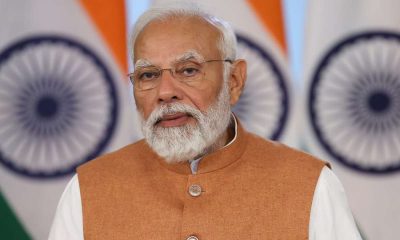Gadgets
Don’t die wondering: Apps may soon be able to predict your life expectancy
Calculating a life expectancy reliably would require a sophisticated system that considers a breadth of environmental, geographic, genetic and lifestyle factors – all of which have influence.

James Jin Kang, Edith Cowan University and Paul Haskell-Dowland, Edith Cowan University
When will I die?
This question has endured across cultures and civilisations. It has given rise to a plethora of religions and spiritual paths over thousands of years, and more recently, some highly amusing apps.
But this question now prompts a different response, as technology slowly brings us closer to accurately predicting the answer.
Predicting the lifespan of people, or their “Personal Life Expectancy” (PLE) would greatly alter our lives.
On one hand, it may have benefits for policy making, and help optimise an individual’s health, or the services they receive.
But the potential misuse of this information by the government or private sector poses major risks to our rights and privacy.
Although generating an accurate life expectancy is currently difficult, due to the complexity of factors underpinning lifespan, emerging technologies could make this a reality in the future.
How do you calculate life expectancy?
Predicting life expectancy is not a new concept. Experts do this at a population level by classifying people into groups, often based on region or ethnicity.
Also, tools such as deep learning and artificial intelligence can be used to consider complex variables, such as biomedical data, to predict someone’s biological age.
Biological age refers to how “old” their body is, rather than when they were born. A 30-year-old who smokes heavily may have a biological age closer to 40.
Calculating a life expectancy reliably would require a sophisticated system that considers a breadth of environmental, geographic, genetic and lifestyle factors – all of which have influence.
With machine learning and artificial intelligence, it’s becoming feasible to analyse larger quantities of data. The use of deep learning and cognitive computing, such as with IBM Watson, helps doctors make more accurate diagnoses than using human judgement alone.
This, coupled with predictive analytics and increasing computational power, means we may soon have systems, or even apps, that can calculate life expectancy.
There’s an app for that
Much like existing tools that predict cancer survival rates, in the coming years we may see apps attempting to analyse data to predict life expectancy.
However, they will not be able to provide a “death date”, or even a year of death.
Human behaviour and activities are so unpredictable, it’s almost impossible to measure, classify and predict lifespan. A personal life expectancy, even a carefully calculated one, would only provide a “natural life expectancy” based on generic data optimised with personal data.
The key to accuracy would be the quality and quantity of data available. Much of this would be taken directly from the user, including gender, age, weight, height and ethnicity.
Access to real-time sensor data through fitness trackers and smart watches could also monitor activity levels, heart rate and blood pressure. This could then be coupled with lifestyle information such as occupation, socioeconomic status, exercise, diet and family medical history
All of the above could be used to classify an individual into a generic group to calculate life expectancy. This result would then be refined over time through the analysis of personal data, updating a user’s life expectancy and letting them monitor it.

Two sides of a coin
Life expectancy predictions have the potential to be beneficial to individuals, health service providers and governments.
For instance, they would make people more aware of their general health, and its improvement or deterioration over time. This may motivate them to make healthier lifestyle choices.
They could also be used by insurance companies to provide individualised services, such as how some car insurance companies use black-box technology to reduce premiums for more cautious drivers.
Governments may be able to use predictions to more efficiently allocate limited resources, such as social welfare assistance and health care funding, to individuals and areas of greater need.
That said, there’s a likely downside.
People may become distressed if their life expectancy is unexpectedly low, or at the thought of having one at all. This raises concerns about how such predictions could impact those who experience or are at risk of mental health problems.
Having people’s detailed health data could also let insurance companies more accurately profile applicants, leading to discrimination against groups or individuals.
Also, pharmaceutical companies could coordinate targeted medical campaigns based on people’s life expectancy. And governments could choose to tax individuals differently, or restrict services for certain people.
When will it happen?
Scientists have been working on ways to predict human life expectancy for many years.
The solution would require input from specialists including demographers, health scientists, data scientists, IT specialists, programmers, medical professionals and statisticians.
While the collection of enough data will be challenging, we can likely expect to see advances in this area in the coming years.
If so, issues related to data compliance, as well and collaboration with government and state agencies will need to be carefully managed. Any system predicting life expectancy would handle highly sensitive data, raising ethical and privacy concerns.
It would also attract cyber criminals, and various other security threats.![]()
This article is republished from The Conversation under a Creative Commons license. Read the original article.
Gadgets
WhatsApp to introduce Native File Sharing feature similar to Apple’s AirDrop
Users can choose to be visible to others without disclosing their phone numbers to people who are not their contacts.

A Meta-owned messaging platform, WhatsApp is all set to introduce a new feature that allows Android users to share files with another user nearby. According to reports, the feature will be developed similar to Apple’s AirDrop.
The file sharing feature nearby is not currently available for beta testers. However, according to a report from WhatsApp feature tracker WABetaInfo, it seems that the feature will soon be introduced. The report reveals a screenshot that shows an option within the app stating, to share files with people nearby, along with a list of nearby users.
It is interesting to note that users can choose to be visible to others without disclosing their phone numbers to people who are not their contacts. In order to share files with other users, one needs to wait for nearby users to accept their request. The process involves a unique interaction, where nearby users can shake their device to receive incoming share requests. It is important to note that this feature is designed with end-to-end encryption to ensure user privacy.
In the upcoming update, WhatsApp is expected to introduce a nearby file-sharing feature. However, the current beta version for Android, which is 2.24.2.20, has addressed a camera issue. Some Android beta testers have reported difficulties in launching the camera within the app after the 2.24.2.13 update. Upon launching, users were presented with an error message that said, can’t start camera, please restart your device. This issue persisted even after restarting the device or relaunching the app.
The latest beta update of WhatsApp, located at 2.24.2.20, has fixed the camera bug. This allows users to launch the camera within the app and share photos and videos with their contacts without any interruptions. As WhatsApp continues its efforts to improve its features and address bugs, users can expect a better messaging experience on the platform.
Gadgets
Meesho mega blockbuster sale: E-commerce platform to offer 80 percent discount on electronics
The e-commerce platform’s first mega blockbuster sale will sell more than 400 brands directly with the help of authorised partners on its digital store called Meesho Mall.

Ahead of the festive season, e-commerce platform Meesho’s mega blockbuster sale is starting on Friday, October 6, 2023. The platform will provide a massive discount of up to 80 percent on different categories such as essentials, accessories, electronics, footwear, etc.
The blockbuster sale is scheduled to conclude on October 13, 2023. Notably, the Softbank backed e-commerce platform is starting its festive sale a day before Flipkart or Amazon’s festive sale goes live. The e-commerce platform’s first mega blockbuster sale will sell more than 400 brands directly with the help of authorised partners on its digital store called Meesho Mall.
Reportedly, the platform also added over 50 lakh new customers during these sales. More than 75 percent of the demand was received from Tier-II cities, including Amravati, Aurangabad, Dehradun, Nellore, Solapur, and Warangal. The platform further claimed that they have added more than 2 lakh sellers in the past two years.
Recently, Meesho affirmed that they have received over 10 million (approx) from its pre-festive sales during Onam, Raksha Bandhan, and Ganesh Chaturthi. The platform has more than 14 lakh sellers, selling approx 12 crore products in 30 different categories.
In an effort to increase the seller base, the company announced the onboarding of non-GST sellers on the platform earlier this week. The GST council announced to permit the e-commerce platform to onboard sellers with turnover of up to Rs 40 lakh.
Prior to Meesho’s Mega Blockbuster Sale, the company introduced a loyalty programme during which eligible users will earn Smart Coins, which the user can redeem every time they make the purchase of any products on the platform.
As per Redseer, over 140 million shoppers are likely to make purchases during the festive season. This will enhance the Gross Merchandise Value (GMV) of the Indian e-commerce sector by 18 to 20 per cent and may touch Rs 90,000 crore as compared to Rs 76,000 crore last year.
Phones & gadgets
Apple launches iPhone 15 series, India price, features, availability
The iPhone 15 series will be available in India from September 22 but iPhone lovers can also pre-order, starting from September 15 onwards.

Apple launched its most anticipated iPhone 15 series, including the iPhone 15, iPhone 15 Plus, iPhone 15 Pro and iPhone 15 Pro Max during the Wonderlust event globally on September 12 night.
The iPhone 15 series will be available in India from September 22 but iPhone lovers can also pre-order, starting from September 15 onwards.
People can buy a new iPhone 15 or upgrade it to the old one. There are five colours available for the people.
According to reports, Apple has been manufacturing the iPhone 15 series in India and China. Apple has moved 7% of its iPhone production to India. Previously, India was not making the newest models. The Centre’s production-linked incentive (PLI) scheme for smartphones played a part in Apple moving its production to India.
The new iPhone 15 has been launched with the same starting price as its prototype, the iPhone 14. The 128GB variant is priced at Rs 79,900, while the 256GB variant costs Rs 89,900. For people who need more storage, the 512GB variant is available for Rs 1,09,900.
This latest iPhone series puffs a 6.1-inch display and comes in five different colours which are pink, yellow, green, blue, and black. While the design remains the same as the previous models, the iPhone 15 features a dynamic island notch instead of the usual notch, which was highly popular among the iPhone 14 Pro phones.
The camera part of the iPhone series has undergone significant upgrades, the new iPhone 15, with an enhanced 48-megapixel primary sensor replaces the 12-megapixel dual camera system which was available in the previous iPhone 14. This significant improvement promises better low-light photography and portrait shots.
The tech giant announced that the iPhone 15 has an all-day battery life, making it more convenient for users to go about their daily activities without worrying about their phone’s battery.
The iPhone 15 Pro models feature a lighter body and thinner bezels. The new AirPods Pro with USB-C charging case will support Lossless Audio with Apple Vision Pro.
Additionally, the iPhone 15 is powered by Apple’s A16 bionic processor, an upgrade from the A15 bionic chipset used in the previous iPhone 14 and iPhone 14 Plus models. The Pro models had the faster and better A16 chip, but now this feature is available in all iPhone 15 models.
The USB-C port on the standard iPhone 15 and iPhone 15 Plus remain limited to lightning speeds up to 480 Mbps. The iPhone 15 Pro and iPhone 15 Pro Max support USB 3 speeds up to 10 Gbps. People will need to buy a separate 1-meter Thunderbolt 4 Pro cable for Rs 5,724 or Rs 10,701 for the 1.8-meter cable to support faster speeds.
The dynamic island notch feature, which can adjust its size according to notifications, was widely discussed before the launch of the iPhone 15. This unique feature can now be available in all models of the phone.
Another important feature of the iPhone 15 is the shift to the USB Type C charging port. Apple has abandoned the lightning port in favour of the more commonly used USB Type C charging port. This means, there is no longer a need for a special iPhone charging cable to be carried around everywhere you go.
-

 2024 Lok Sabha Elections19 hours ago
2024 Lok Sabha Elections19 hours agoPM Modi calls for high voter turnout in second phase of Lok Sabha elections 2024, says your vote is your voice
-

 2024 Lok Sabha Elections14 hours ago
2024 Lok Sabha Elections14 hours agoLok Sabha election 2024: Nearly 50% voter turnout recorded in second phase till 3 pm
-

 India News18 hours ago
India News18 hours agoSalman Khan house firing case: NIA interrogates arrested shooters Sagar Pal, Vicky Gupta for three hours
-

 2024 Lok Sabha Elections12 hours ago
2024 Lok Sabha Elections12 hours agoElection Commission books BJP MP Tejasvi Surya for seeking votes in the name of religion
-

 2024 Lok Sabha Elections17 hours ago
2024 Lok Sabha Elections17 hours agoLok Sabha elections 2024: 102-year-old man walks to polling booth to cast his vote in Jammu













